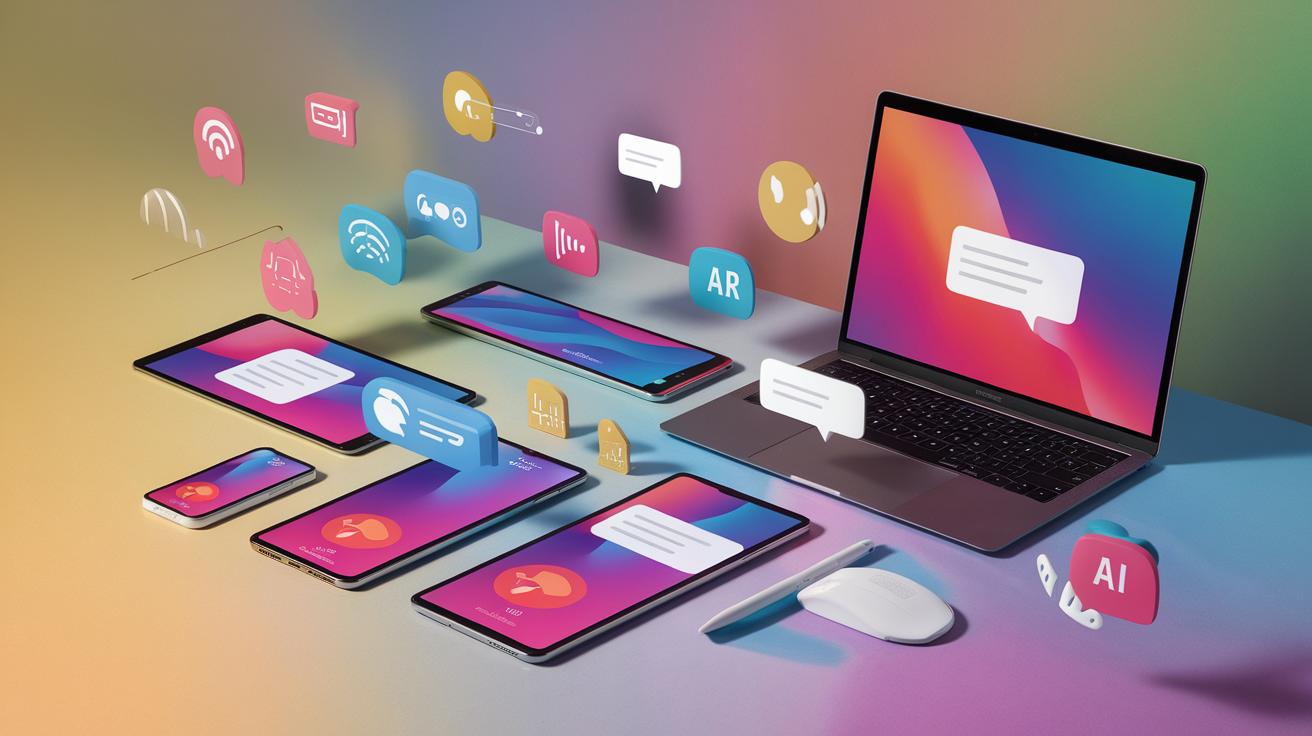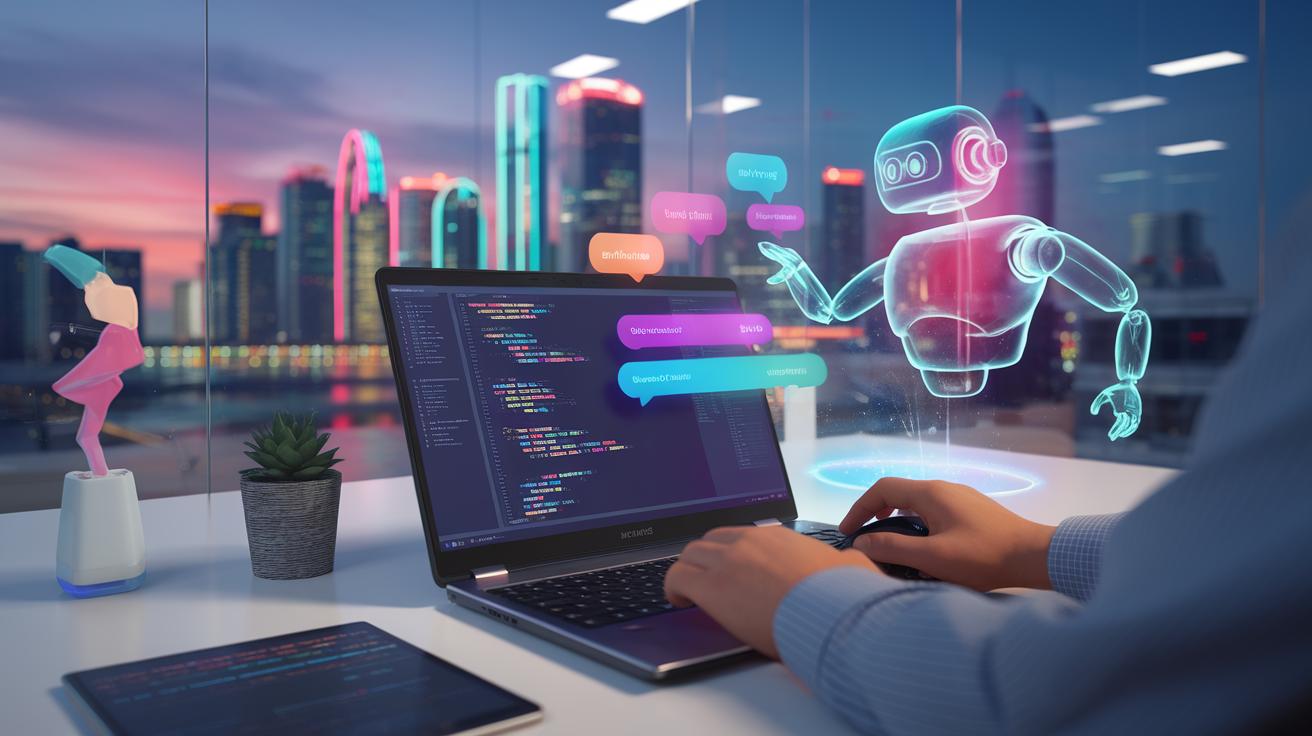Introduction
The advent of AI-powered chat technologies marks a pivotal shift in how businesses engage with users, creating smarter and more personalized interactions. Documents and studies reveal that AI-enhanced chat solutions not only streamline communication but also dynamically adapt to meet user needs, thereby enhancing overall customer satisfaction. With the rise of technologies like ChatGPT, the potential for automating customer service and support has never been greater. This article delves into the transformative impact of AI-powered chats in custom chat widget design, illuminating how businesses can create tailored experiences.
As firms adapt to consumers’ evolving expectations in a digital-first landscape, integrating smart, interactive chat features has become essential. AI chat widgets are designed to understand and respond to user queries in real-time, improving engagement while reducing operational costs. This article will explore the critical components of designing an AI-powered chat widget, examine its functionalities, and discuss best practices for implementation that can redefine user experience in various platforms and industries.
Understanding AIPowered Chat Technologies Redefining Custom Chat Widget Design
Fundamentals of AI-Powered Chat Technologies
AI-powered chat technologies represent a significant advancement in how brands interact with their customers. At their core, these technologies utilize advanced algorithms, natural language processing (NLP), and machine learning to enable chatbots to understand and respond to user queries in a human-like manner. The backbone of these systems lies in vast datasets that train models to recognize patterns in language and intent, thereby enhancing the conversational experience.
There are various types of AI chatbots, each designed for specific applications. Rule-based chatbots follow predefined pathways and respond only to specific inputs, making them limited in their conversational capabilities. In contrast, AI-driven chatbots leverage machine learning to interpret context and generate responses, allowing for fluid interactions.
Among the widely used applications of AI chatbots are customer service solutions, personal assistants, and e-commerce support systems. For instance, a customer service chatbot can deftly handle inquiries about product availability, return policies, and technical support, ensuring customers receive timely assistance. Personal assistants, such as those integrated into smart devices, actively manage tasks, answer queries, and facilitate home automation. In e-commerce, chatbots help users navigate products, providing recommendations based on previous interactions, thus streamlining the shopping experience.
Technology Behind AI Chatbots
The technology behind AI chatbots involves a combination of algorithms and frameworks such as GPT-3, BERT, or Rasa for language understanding, machine learning models, and APIs that connect these programs to user interfaces. NLP techniques are employed for analyzing user input, allowing chatbots to discern intent and context. This interplay of technologies results in a responsive chat interface that transforms digital interactions.
As AI continues to evolve, the capabilities of chatbots will expand further, offering more sophisticated solutions that align closely with user expectations. This continual enhancement promises to reshape the landscape of customer engagement through innovative and personalized experiences within chat widgets.
The Importance of Customization in Chat Design
Tailoring User Interactions for Enhanced Engagement
Customization in chat widget design is pivotal in fostering engaging user experiences. Unlike generic chat interfaces, tailored designs are meticulously crafted to resonate with the target audience’s preferences and needs. Personalization cultivates a sense of connection, making users feel understood and valued. This emotional link can drastically enhance engagement, as users are more likely to interact positively with systems that cater specifically to their preferences.
One of the primary advantages of personalized chat experiences is their ability to streamline user interactions. By incorporating elements like custom greetings and responses based on user behavior and historical data, chat widgets can create a seamless communication flow. Personalized conversation strategies ensure that users receive relevant information promptly, all while fostering a friendly and approachable atmosphere. For instance, a user returning to a service may feel more welcomed when the chat widget remembers their name and recent interactions, offering a customized prompt or assistance.
Leverage for Improved User Experience
The pivotal role of customization extends beyond mere aesthetics; it encompasses the very essence of user experience. A well-designed chat widget that reflects the brand identity enhances recognition and trust. Users are inclined to return to services that exhibit attention to detail and adaptability in engagements. For example, customizable colors, fonts, and iconography can align the chat interface with a company’s branding, fostering recognition and loyalty.
Tailored chat interactions enhance the overall satisfaction of users. By analyzing individual preferences, interests, and even behavioral cues, chat widgets powered by AI can deliver unique experiences in real-time. This approach not only streamlines communication but also amplifies user satisfaction, as conversations become increasingly relevant and engaging.
The interactive nature of technology allows for continuous refinement based on user feedback. Systems can learn from user interactions, adjusting their responses and appearance to better suit individual and collective preferences. This adaptability reinforces the notion that effective customization is not a one-time endeavor but an evolving process that caters to changing user expectations.
The significance of customization in chat widget design cannot be overstated. Tailored experiences lead to enhanced user engagement, satisfaction, and loyalty, illustrating that when technology learns to speak the language of its users, the possibilities for user experience improvement are boundless.
Key Features of an Effective AIPowered Chat Widget Redefining Custom Chat Widget Design
Essential Functionalities for Robust Engagement
The landscape of AI-powered chat widgets is evolving, highlighting the importance of incorporating key functionalities that facilitate meaningful interactions. As organizations seek to connect with users effectively, chat widgets must offer a seamless user experience tailored to diverse needs. Central to this is the integration of multi-lingual support, context-aware responses, and interoperability with existing platforms.
Multi-lingual support represents a significant advantage in global communication. By enabling chat widgets to converse in various languages, businesses can engage a broader audience and provide localized experiences. This feature promotes inclusivity, ensuring that language barriers do not hinder effective communication. Users are more likely to engage with chat interfaces that speak their language, thereby enhancing user satisfaction and retention. AI-driven translation tools have made it easier to implement this function, providing accurate, real-time translations that foster natural conversations.
Context-aware responses are another critical feature that enhances user interaction. Such capabilities allow chat widgets to understand the nuances of conversations, including user intent, prior interactions, and emotional tone. By leveraging machine learning algorithms, chatbots can provide relevant and timely responses based on the context of the discussion. This level of intelligence not only improves user experience but also minimizes frustration that may arise from irrelevant or generic replies. For instance, if a user inquires about order status, a context-aware chatbot can immediately access previous transactions to provide specific information, thereby streamlining the interaction.
Integration capabilities are equally vital in modern chat widgets. They must connect seamlessly with various platforms, such as CRM systems, social media, and e-commerce solutions. This connectivity ensures a unified customer experience across touchpoints, enabling businesses to gather valuable insights and manage user data efficiently. When chat widgets are integrated into a broader system, they can deliver personalized, data-driven interactions that are both engaging and effective.
These essential functionalities not only redefine the design of chat widgets but also empower businesses to create innovative interactions that resonate with users. As organizations continue to leverage AI technologies, the potential for elevated user experiences in chat interfaces will only expand, setting new standards in user engagement.
Best Practices for AIPowered Chat Widget Implementation
Implementing AI-powered chat widgets effectively requires a strategic approach that prioritizes user experience and operational efficiency. To ensure a successful deployment, businesses need to navigate common pitfalls while adhering to best practices that harness the potential of AI technologies.
Strategic Planning and Design
The groundwork for effective chat widget implementation lies in comprehensive planning. Define clear objectives for the chat widget, such as enhancing customer support, increasing sales, or facilitating user education. Understanding the target audience is equally important; conducting user research helps tailor the chat widget to meet specific needs. An intuitive design that aligns with the overall website aesthetics ensures a seamless integration, fostering user trust and comfort.
Effective Training of AI Models
Central to the functionality of AI-powered chat widgets is the training of the AI models that power them. Utilizing high-quality, diverse datasets allows for improved contextual understanding and response accuracy. Regular updates and retraining help maintain relevancy in responses, especially as user preferences and language evolve. Incorporating user feedback can also refine the AI’s responsiveness, making it more empathetic and relevant to users’ queries.
Integration and Compatibility
Successful deployment hinges on the chat widget’s integration with existing systems, such as CRM platforms and messaging applications. This ensures a unified approach to customer interaction, enabling the AI to access and utilize relevant user data for personalized experiences. Ensuring cross-platform compatibility is also vital, as users may engage from various devices. Test the widget across different environments to identify and resolve potential issues prior to launch.
Monitoring, Analytics, and Continuous Improvement
Post-implementation, organizations should monitor the performance of the chat widget closely. Utilizing analytics tools allows providers to gauge user interaction, identify common queries, and uncover areas for enhancement. Establish key performance indicators (KPIs) focusing on user satisfaction, engagement rates, and issue resolution times. Such metrics provide valuable insights into the widget’s effectiveness, laying the groundwork for ongoing improvements and ensuring that the technology remains relevant in a dynamic market.
While the benefits of AI-powered chat widgets are substantial, organizations must remain vigilant against common pitfalls, such as neglecting user privacy or failing to provide adequate fallback options when the AI cannot effectively address user inquiries. Prioritizing user-centric design, continuous training, and robust integration strategies can lead to the successful deployment of innovative chat solutions that elevate user experience.
Challenges and Ethical Considerations AIPowered Chat Redefining Custom Chat Widget Design
The integration of AI in chat technologies has undoubtedly revolutionized user interactions, yet this transformation brings forth a variety of challenges and ethical considerations that cannot be overlooked. As chat widgets grow increasingly sophisticated, the implications of data privacy and security become paramount. Organizations must ensure that user data is handled responsibly and in compliance with regulations such as GDPR and CCPA.
Data privacy remains a significant concern as chat widgets process vast amounts of personal information. Users often share sensitive data when seeking assistance, and the potential for data breaches raises alarms. Businesses must adopt strict data governance frameworks, implementing robust encryption methods and access controls to protect user information. Failure to do so not only risks compliance violations but could severely damage user trust and brand reputation.
Security challenges extend beyond data protection. The evolving nature of cyber threats, including phishing attacks and malicious bots, demands continuous vigilance. Organizations must regularly update their security protocols and engage in comprehensive testing to identify vulnerabilities within their chat systems. Furthermore, educating users on safe chat practices can help mitigate potential risks, fostering a more secure interaction environment.
Ethical considerations of AI interactions also play a crucial role in shaping the future of chat widgets. The design and functionality of these automated systems must prioritize transparency and fairness. Users should be informed when they are interacting with AI rather than a human, and chatbot responses must be unbiased and equitable. This necessitates rigorous testing and training of AI models to ensure they do not perpetuate discrimination or misinformation.
The potential for AI to influence decision-making raises ethical dilemmas. As chat widgets become more personalized, they may manipulate user choices or behaviors unintentionally. Developers must reflect on the implications of their AI systems and adopt ethical guidelines that prioritize user empowerment and informed consent.
As organizations navigate these challenges, a clear commitment to ethical AI practices must guide their strategies. Balancing innovation with responsibility in the development of AI-powered chat technologies will ultimately determine the success of custom chat widget design, paving the way for user experiences that are not only engaging but also secure and ethical.
Future Trends in AIPowered Chat Design Redefining Custom Widget Design
Anticipating Innovations in AI Chat Technologies
The landscape of AI-powered chat and custom chat widget design is rapidly evolving, reflecting changing user expectations and technological advancements. As organizations increasingly recognize the importance of delivering enhanced user experiences, there are several trends that are poised to redefine this sphere. One key trend is the vertical integration of advanced natural language processing (NLP) capabilities into chat widgets. This integration will enable more fluid, context-aware conversations, allowing chat interfaces to understand user intent with greater accuracy and respond with appropriate actions or information.
Another significant trend is the personalization of chat experiences. By leveraging machine learning algorithms, chat widgets can analyze user behavior and preferences, offering customized interactions that resonate with individual users. This hyper-personalization extends beyond merely using a user’s name; it encompasses tailored responses, recommendations, and proactive engagement strategies designed to elevate user satisfaction and engagement.
The incorporation of multimodal capabilities into chat widgets is expected to gain traction. Users increasingly expect seamless transitions between text, voice, and visual inputs. The future of chat design may include hybrid interfaces that blend these modes, allowing for more intuitive and accessible dialogue. For instance, users might initiate a chat via voice command and shift to text input without losing the conversational thread.
Embracing Emerging Technologies and User Expectations
Emerging technologies such as augmented reality (AR) and virtual reality (VR) are likely to influence future chat designs significantly. Imagine a chat widget that not only communicates through text but also overlays relevant information or interactive visuals within a user’s real-world environment. This fusion of AR and chat could revolutionize how support services, e-commerce, and educational content are delivered, making interactions more immersive and productive.
As data privacy and ethical considerations remain paramount, users will demand transparency and control over their data more than ever. Future chat designs will need to integrate user-friendly privacy settings and clear communication regarding data usage. This will foster trust and strengthen user relationships with automated chat systems.
The trajectory toward sophisticated, personalized, and ethically-compliant AI chat interfaces signals an exciting future for custom chat widget design. Organizations that invest in these innovations will not only meet user expectations but also differentiate themselves in a competitive marketplace.
Conclusions
This exploration of AI-powered chats and custom chat widget design reveals a landscape brimming with potential. Businesses willing to embrace these technologies stand to gain significantly in customer engagement and satisfaction. The ability of AI to learn from user interactions centers around enhanced personalization, ultimately leading to a more user-friendly experience. Integrating AI into chat systems increases efficiency in transaction processing, as well as fosters enhanced rapport between brands and consumers.
The future of customer interactions is heavily influenced by AI advancements. An effective chat widget design goes beyond merely responding to queries; it facilitates meaningful conversations and assists in building lasting relationships. Organizations that adopt these innovative solutions will not only improve their service delivery but also set new standards in customer engagement that competitors will strive to match.



















